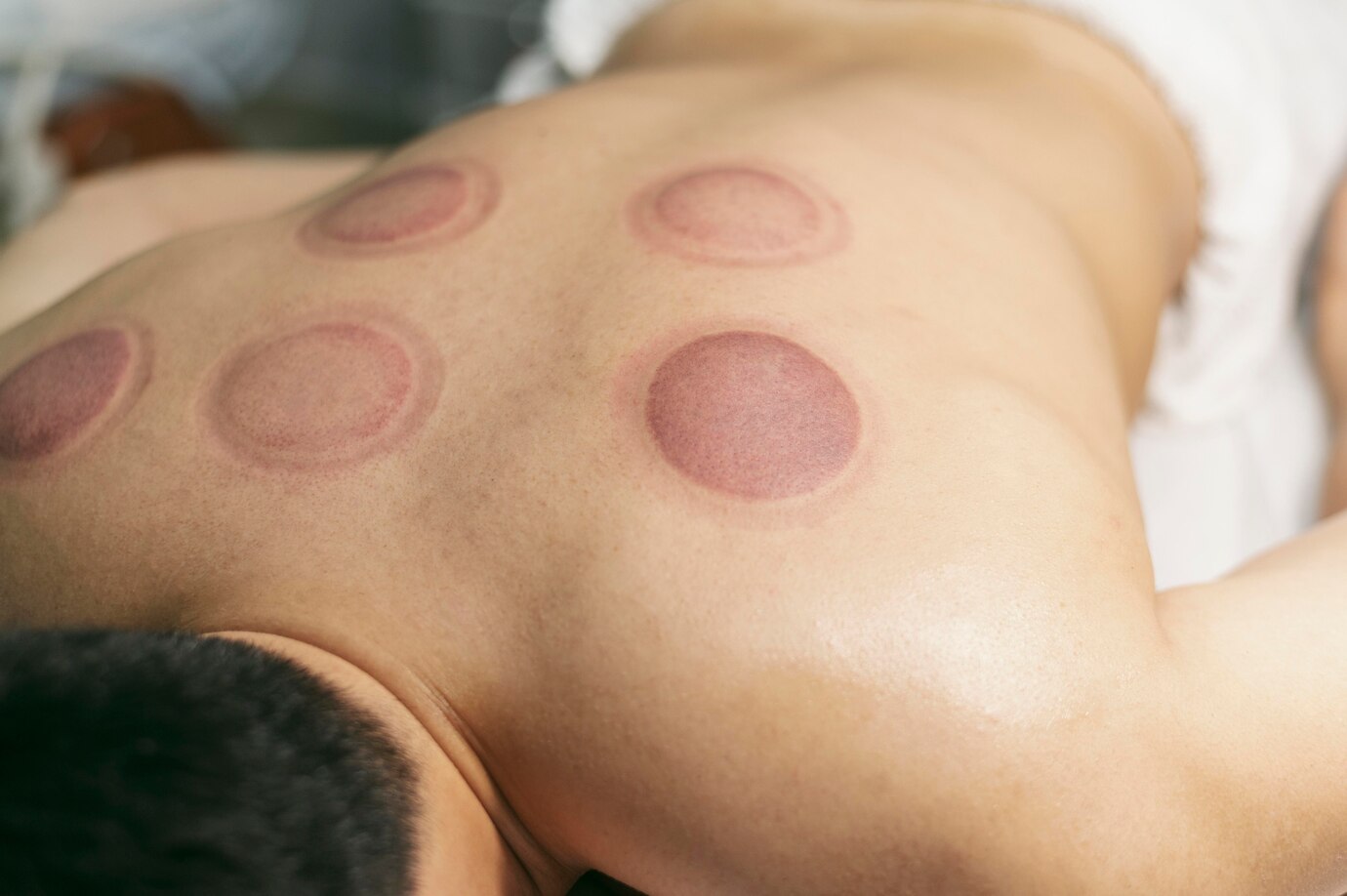Key Takeaways
– Cupping therapy improves circulation, relaxes muscles, and supports overall well-being.
– Different cupping techniques offer unique benefits, from pain relief to detoxification.
– Seek a qualified practitioner to ensure a safe and effective treatment.
For centuries, people have used cupping therapy to boost circulation, relieve muscle tension, and enhance overall well-being through the power of suction. In recent years, cupping has gained popularity as more people look for natural ways to manage stress, pain, and muscle tension. From athletes to celebrities, everyone is curious about the potential benefits of cupping.
But what’s all the hype about? Let’s explore why this age-old therapy is making such a big comeback and how it might just be the wellness boost you’ve been looking for!
Benefits of Cupping Therapy
Cupping therapy has been around for centuries — and for good reason. This ancient practice is known for easing muscle tension, boosting circulation, and promoting deep relaxation. Whether you’re an athlete seeking faster recovery or simply looking for a natural way to unwind from daily stress, cupping offers a holistic approach to feeling refreshed and recharged.
Improved circulation
Cupping therapy increases blood flow to targeted areas by creating suction on your skin, drawing oxygen and nutrients that help your muscles and tissues heal more efficiently. When circulation improves, your body also gets better at flushing out waste products and toxins. This keeps your system running smoothly and leaves you feeling more energized. Think of cupping as a way to give your body a little push to recover and feel refreshed.
Pain relief
Cupping therapy helps relieve pain by easing tension in your muscles and connective tissues. The gentle suction gently lifts and stretches the skin, releasing tight spots and knots and allowing your muscles to relax. And as the tension dissipates, pain naturally decreases, providing a sense of relief and comfort.
By improving circulation, cupping also reduces inflammation and speeds up the healing process for issues like chronic pain, muscle soreness, and joint discomfort. Many people find that cupping also improves their overall mobility and flexibility. It’s a simple yet effective way to feel better and move more freely without relying on medication or invasive treatments.
Muscle recovery
After intense physical activity, your muscles need time to recover. Cupping therapy speeds up this process by easing muscle tension and improving blood flow. The suction lifts and loosens tight muscles, reducing soreness, and preventing stiffness from setting in.
By increasing blood flow, cupping supplies essential nutrients for muscle repair while helping remove lactic acid and other waste that causes fatigue and discomfort after exercise. This natural approach to recovery leaves you feeling refreshed and ready for your next workout, no matter if you’re a dedicated athlete or simply maintaining an active lifestyle.
Stress reduction
Cupping therapy isn’t just about physical relief — it also works wonders for calming the mind. By easing muscle tension, cupping sends a signal to your nervous system to relax, stimulating the release of dopamine and serotonin in your body. This helps shift your body out of a “fight or flight” mode to a relaxed, peaceful state.
Think of those days when stress tightens your shoulders or neck. Cupping targets these tension hotspots, releasing built-up pressure and allowing you to breathe more easily. It’s like hitting a reset button for both your body and mind.
Beyond its physical benefits, the gentle sensation of cups gliding on your skin creates a calming, almost meditative experience. Therefore, for anyone looking to unwind and de-stress naturally, cupping offers a unique and powerful way to feel lighter and more at ease.
Healthy skin

One of the most effective ways to improve your skin health is through cupping therapy. That’s because this ancient procedure boosts circulation, encouraging cell regeneration and removing toxins from your body, ultimately contributing to healthier skin.
Cupping therapy may also support collagen production, a protein that helps maintain skin’s elasticity and youthful appearance. Some people even use it to minimize the appearance of scars and stretch marks, as it helps break down stagnant tissue and improve skin texture.
While more research is needed to confirm all its benefits, cupping remains a popular, non-invasive option for those seeking healthier skin naturally.
Detoxification
Cupping therapy is thought to support the body’s natural detox processes by improving circulation and stimulating the lymphatic system.
Improved circulation allows the body to effectively eliminate toxins and cellular debris that can accumulate in tissues. Additionally, an activated lymphatic system aids in removing excess fluid, waste, and other harmful substances, supporting overall health and wellness.
While cupping cannot replace other detox methods, it may complement them, offering a holistic approach to detoxification and improved health.
Boosted immune function
Cupping therapy is also known for giving your immune system an extra boost. As oxygen and nutrients are being delivered to tissues, your body becomes better equipped to ward off infections and heal.
Additionally, cupping can trigger a response from your body’s defense mechanisms, encouraging the production of white blood cells. These cells are vital in fighting off infections, helping you stay healthier and feel more energized. It’s a natural way to support your immune health and give your body a helping hand when it needs it most.
Types of Cupping Therapy
Cupping therapy isn’t a one-size-fits-all treatment. There are different methods designed to fit various needs and preferences, whether you’re looking for muscle relief, detoxification, or general relaxation. Let’s explore the three main types: dry cupping, wet cupping, and fire cupping.
Dry cupping
Dry cupping is the most common and straightforward method. During this process, cups are placed on the skin to create suction without making any cuts. The suction is usually created using a pump or by squeezing air out of silicone cups before placing them on the body. This draws the skin and muscle into the cup, increasing blood flow to the area.
Dry cupping is known for its ability to reduce muscle tension and promote relaxation. It’s a popular choice for those looking for a gentle, non-invasive therapy to ease pain and stress.
Wet cupping
Wet cupping follows a similar process to dry cupping but includes an added step — after the suction, the practitioner makes tiny incisions on the skin. The cups are then reapplied to extract a small amount of blood, a process thought to aid in toxin removal and enhance circulation. The suction is typically created by heating the air inside the cup or using a manual pump.
Wet cupping is often used for detoxification and pain relief, but it should only be performed by a trained professional to maintain safety and hygiene.
Fire cupping

Fire cupping takes a more traditional approach. A flame is briefly placed inside the cup to heat the air, creating a vacuum as the cup is swiftly applied to the skin. As the air cools, it creates suction, suction is created, drawing the skin and muscles into the cup.
Fire cupping is known for its intense suction and is often used for deep muscle relief and improved circulation. Fire cupping requires skill and experience to perform safely, so it’s essential to go to a qualified practitioner who knows how to handle the tools and techniques involved.
What to Expect in a Cupping Session
A typical cupping therapy session starts with an assessment. The practitioner asks about your health, areas of discomfort, and what you hope to achieve with the treatment. This helps them determine where to place the cups and which type of cupping is best for you.
Before your appointment, you should stay hydrated, as it helps your body flush out any toxins released during the treatment. Avoid heavy meals or caffeine right before the session, as they may cause discomfort. The practitioner will also check your skin for any cuts, wounds, or irritations to ensure safe cup placement.
Once you’re ready, you’ll lie down comfortably while the practitioner places the cups on your skin. Depending on the type of cupping, they’ll create suction using a pump, heat, or by squeezing air out of silicone cups. The cups stay on for about 10 to 15 minutes before being gently removed.
After the session, drinking water can further aid in eliminating released toxins. It’s also best to rest and avoid intense activities for the rest of the day. Mild soreness or redness is normal and usually fades within a few days.
Risks and Considerations

While cupping therapy is generally safe, it does come with some potential risks. Possible side effects include bruising, redness, and mild soreness in the treated areas. These marks usually fade within a few days but can be more noticeable on sensitive skin. Some individuals may also feel lightheaded or nauseous immediately after a session.
Skin irritation is another possibility, particularly for those with sensitive skin or allergies to oils used during treatment. To prevent discomfort, make sure to inform your practitioner of any skin conditions or allergies beforehand.
Cupping may not be suitable for everyone. Pregnant women and individuals taking blood-thinning medication should avoid it. Additionally, anyone with bleeding disorders, skin conditions, heart disease, cancer, or severe chronic conditions should consult a healthcare provider before undergoing cupping therapy.
For a safe and effective experience, it’s essential to visit a qualified practitioner who follows strict hygiene and safety protocols. They should use sterilized cups and have the necessary training to minimize risks and ensure the best results.
The Bottom Line
Cupping therapy offers numerous benefits, from boosting circulation and alleviating pain to reducing stress and enhancing skin health. While it’s a natural way to support overall well-being, it’s important to understand the different types, what to expect during a session, and any potential risks.
If you’re fascinated by this ancient healing practice, why not turn your interest into a career? Join the AIAM acupuncture program and get hands-on training in cupping and other traditional therapies.
Frequently Asked Questions
Does cupping hurt?
Cupping usually isn’t painful, but you may feel a pulling or tight sensation. Mild soreness or bruising can occur afterward.
Can cupping therapy help with weight loss or cellulite?
Cupping isn’t a weight loss method, but it may reduce the appearance of cellulite by improving circulation and skin elasticity.
Is cupping safe during pregnancy or breastfeeding?
Cupping is generally not recommended during pregnancy, especially on the abdomen or lower back. However, it may be safe while breastfeeding if performed by a qualified practitioner.
Can I perform cupping at home without professional help?
It’s best to see a trained practitioner, as improper technique can cause skin damage or other complications.